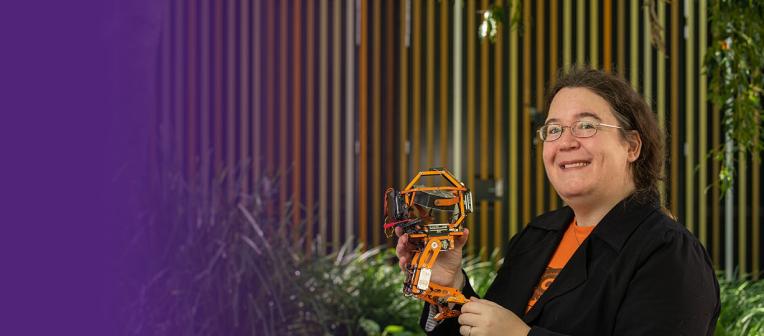Dr Pauline Pound’s robots may be tiny, but they’re taking big steps in the field of robotics.
Pauline has a passion for mechatronics – technology which combines electronics with mechanical engineering – that's super infectious, and she wants to spread her love for all things robotic even further.
Robots that clean your house and carry your groceries shouldn’t be exclusively for the rich and famous. If your gran needs a hand to reach above the fridge for a light spot of dusting, she should be able to get a robot to do that. If your mate in a wheelchair could benefit from a robot carting along some groceries from the store, they should have that option.
But to make these types of nifty robots accessible to a wider range of consumers, they need to be more affordable, which takes a bit of work. That’s where Pauline’s Tiny Giant Robots come in.
Pauline is an Associate Professor in mechatronics in the School of Electrical Engineering and Computer Science at UQ. Find out more about her teaching approach.
Making robots accessible
Pauline confesses to always having wanted a giant robot that could crush the cars of her enemies.
“However, since I don’t have the budget for a humongous robot, I’ve had to start by building one 1:100th size," she says.
And so the idea for the Tiny Giant Robot (TGR) was born.
But what exactly is a Tiny Giant Robot? And why does it have to be tiny before it can be made big?
“The Tiny Giant Robot is a new type of walking machine that uses a high-speed gyroscope to balance,” says Pauline.
"Unlike a conventional bipedal walking robot which uses carefully computed foot ground-contact forces to balance, the TGR uses precession torques produced by tilting its gyroscope to stay upright.”
If you followed that – good for you. If you didn’t, you basically just need to know this: Pauline’s approach to building a walking robot is, on the whole, much simpler than most of the models in market today and uses less expensive parts, making it more affordable to manufacture.
“Walking in robots is very complex, and a lot of research and funding has gone into dealing with this complexity,” says Pauline.
“Famous walking robots such as those developed at Boston Dynamics and Honda are expected to have price tags in excess of one million dollars.
"Our approach promises to reduce the cost to only a few thousand dollars."
The aim is to start small, detailing exactly what methods and parts work best for the TGR, so that eventually, Pauline's robots can go from chicken-sized prototypes to human-sized helpers.
“We already have a working prototype, with a second-generation version nearing completion,” she says.
“It’s an exciting time for the project!”
Pauline’s vision is to make her robots accessible to everyday people and businesses. The affordable TGR will be able to help with everything from carrying laundry to patrolling compounds. Eventually, they might even crush the cars of your enemies (though we'd recommend trying to talk through your issues first).

Pauline with the prototype of her Tiny Giant Robot.
More cool robot stuff
The TGR isn’t the only project Pauline’s got up her sleeve. When we asked her what other cool robot stuff she’s got going on, her immediate response was, “Where to begin?!”.
“I’m building novel types of robot helicopters for all sorts of applications – flying for longer, carrying heavier payloads and avoiding wind gust disturbances,” she says.
In fact, Pauline was part of a team at Yale University who were the very first to figure out how to manipulate unstructured objects using a hovering robot outdoors. Subsequent Amazon and Google delivery drones can all trace their lineage back to that original discovery.
“I’m also building advanced sensor devices to measure the world that robots move and work in, with world-best sensitivity and precision,” she says.
One of the best things about all these projects is that current UQ engineering students get to work on them too. Some students even have their names included on patents and international publications.
“If there’s something that I can build, that’s great,” says Pauline.
“If there’s something that I can build with someone, that’s even better.”
“Having the opportunity to take a student along and involve them in the work that I do just means sharing the fun around – more hands, more minds and more opportunities to come up with great ideas.”
The excitement of the unknown
Sharing her work with others isn’t the only thing Pauline finds exciting though. She’s also an avid problem-solver.
“The biggest challenge is finding the right problem to solve,” she says.
But how do you identify the right problem, and what makes it so?
Problem finding with Pauline
According to Pauline, there are 3 types of problems in the world, and they all hold varying degrees of interest for an intrepid inventor such as herself:
- Some problems are simply a straightforward implementation of existing principles or technology – not very interesting.
- Some problems are intractable because they are precluded by fundamental laws of physics and no solution can exist – also not very interesting.
- But some problems are not straightforward, yet clearly solvable – tantalising because you know there is a solution, but you don’t know what or how.
For Pauline, the excitement lies in the unknown, and the prospect of making it known.
So, can robots save the world?
If you’re a die-hard Disney fan with a penchant for believing fun yet far-fetched stories, the answer is probably a resounding yes. In reality, however, the feats of robots are a little less sensationalised (but still incredibly impressive!).
“Mechatronics isn’t just creating a better tomorrow, it’s creating the world we live in today,” says Pauline.
“We owe so much to the factory systems, aviation, power stations and logistics chains that underpin the modern commercial and industrial spheres.”
Robots aren’t saving humanity by helping pilot X-wings in outer space or taking down evil overlords. Humans are creating robots that can enhance our everyday lives in small ways, which over time, can make a huge difference.
“As our automation and robotics systems improve, the costs of products, food and living will come down, making a better life for everyone.”
While we may not be at a point yet where every household has a Baymax, C-3PO or Wall-E, with a little help from mechatronic experts like Pauline, we’re well on our way there.
Discover the Bachelor of Engineering (Honours) Explore all our undergraduate programs






